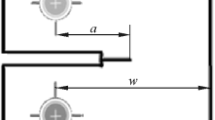Abstract
The paper deals with calculation of a plastic zone near a crack tip in a homogeneous elastoplastic solid and near a corner point of the boundary of this solid. The calculations are conducted for a solid subject to plane strain and within the framework of models with plastic strips. It is shown that in comparison with the widely used model with two straight slip-lines, the process of plastic deformation is described by the “trident” model more accurately. The results of calculations of the plastic zone by the “trident” model that correspond to different stages of the development of plastic deformation are given for a crack of normal separation in a quasibrittle material.
Similar content being viewed by others
References
A. A. Kaminskii, L. A. Kipnis, and V. A. Kolmakova, “Calculation of the plastic zone at a crack tip within the framework of the “trident” model,”Prikl. Mekh.,33, No. 5, 70–76 (1997).
A. A. Kaminskii and S. B. Nizhnik, “Examination of the laws governing the change in the plastic zone near the crack edge and the characteristics of the crack resistance of metal materials depending on their structure (review),”Prikl. Mekh.,31, No. 10, 3–27 (1995).
A. A. Kaminskii, G. I. Usikova, and E. A. Dmitrieva, “Experimental investigation of the plastic-strain distribution near a crack apex under static loading,”Prikl. Mekh.,30, No. 11, 69–75 (1994).
L. A. Kipnis and G. P. Cherepanov, “Application of the choice principle to the problem of initial development of slip lines from a corner point,”Prikl. Mat. Mekh.,53, No. 1, 159–164 (1989).
M. Ya. Leonov, P. M. Vitvitskii, and S. Ya. Yarema, “Plastic strips of stretched plates with a crack-like concentrator,”Dokl. Akad. Nauk SSSR,148, No. 3, 541–544 (1963).
V. V. Panasyuk and M. P. Savruk, “The model of plastic strips in elastoplastic problems of fracture mechanics,”Fiz. Khim. Mekh. Mater,28, No. 1, 49–68 (1992).
V. Z. Parton and P. I. Perlin,Methods of the Mathematical Theory of Elasticity [in Russian], Nauka, Moscow (1981).
M. P. Savruk and A. M. Danilovich, “Propagation of slip strips near the tip of a boundary crack under plane strains,”Prikl. Mekh.,30, No. 1, 56–61 (1994).
G. P. Cherepanov,The Mechanics of Brittle Fracture [in Russian], Nauka, Moscow (1974).
G. P. Cherepanov, “Plastic lines of rupture at the tip of a crack,”Prikl. Mat. Mekh.,40, No. 4, 720–728 (1976).
A. A. Kaminskii and G. V. Galatenko, “On the temperature dependence of fracture toughness in the brittle-to-ductile transition region,”Prikl. Mekh.,35, No. 4, 80–86 (1999) (Int. Appl. Mech.,35, No. 4, 398–404 (1999)).
A. A. Kaminskii and G. V. Gavrilov, “Subcritical growth of macrocracks in an aging orthotropic viscoelastic composite under static loads,”Prikl. Mekh.,35, No. 6, 92–97 (1999) (Int. Appl. Mech.,35, No. 6, 621–626 (1999)).
A. A. Kaminskii, L. A. Kipnis, and V. A. Kolmakova, “On the Dugdale model for a crack at the interface of different media,”Prikl. Mekh.,35, No. 1, 63–68 (1999) (Int. Appl. Mech.,35, No. 1, 58–63 (1999)).
N. Levy, P. V. Marcal, W. J. Ostergren, and J. R. Rice, “Small scale yielding near a crack in plane strain: a finite element analysis,”Int. J. Fracture Mech.,7, No. 2, 112–122 (1971).
S. B. Nizhnik, “Study of crack resistance of plastically anisotropic metal materials,”Prikl. Mekh.,35, No. 4, 87–94 (1997) (Int. Appl. Mech.,35, No. 4, 405–412 (1999)).
Additional information
S. P. Timoshenko Institute of Mechanics, National Academy of Sciences of Ukraine, Kiev. Translated from Prikladnaya Mekhanika, Vol. 36, No. 3, pp. 95–100, March, 2000.
Rights and permissions
About this article
Cite this article
Kaminskii, A.A., Kipnis, L.A., Kolmakova, V.A. et al. The use of the “trident” model in the analysis of plastic zones near crack tips and corner points. Int Appl Mech 36, 372–376 (2000). https://doi.org/10.1007/BF02681920
Received:
Issue Date:
DOI: https://doi.org/10.1007/BF02681920




